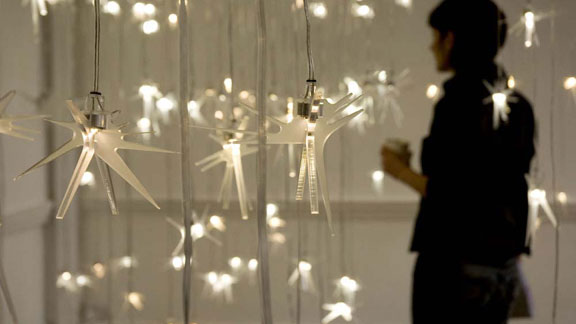The LightHive: Luminous Architectural Surveillance
 [Image: A glimpse of London's LightHive, by Alex Haw, on display last week].
[Image: A glimpse of London's LightHive, by Alex Haw, on display last week].An installation called the LightHive closed last week at the Architectural Association in London.
Designed by architect, actor, theorist, and writer Alex Haw, the hive functioned as a new form of "luminous architectural surveillance," somewhere between sculpture, optical device, and high-end interior decoration – an immersive chandelier, if you will.
According to the UK-based ArtsHub, Haw's LightHive "pushes CCTV into another dimension."
 [Image: Preliminary point-cloud study for the LightHive, executed by Marc Fornes].
[Image: Preliminary point-cloud study for the LightHive, executed by Marc Fornes].Specifically, the hive consists of "a surveillance network" – connected to nearly 7.5km of LED wiring – that "records the movement of people through the building" (where "the building" is London's Architectural Association in Bedford Square).
The LightHive then "transmutes the energy into bursts of light, which create an 'immersive form of 3d CCTV'."


 [Images: Glimpses of the LightHive, an indoor constellation aware of those who view it. Image one, two, and three – and a lot more here].
[Images: Glimpses of the LightHive, an indoor constellation aware of those who view it. Image one, two, and three – and a lot more here].From a description of the exhibition:
- The space thus operates like a 3D X-ray of the building’s activity, a kind of constantly updating surround-light CCTV, a spatial model of the entire School’s performance fluctuating over the course of hours, days and weeks.

 [Images: The LightHive as digital model (by Marc Fornes) and material execution].
[Images: The LightHive as digital model (by Marc Fornes) and material execution].I love just thinking about the possibility that, say, all the lights in Bloomsbury, from desk lamps and bathroom fixtures to fluorscent bulbs at the nearest Pret a Manger, might someday act as a huge sensory mechanism, responding and dimming in response to the passage of people in the streets. Or parts of Tokyo light up, LightHive-like, illustrating in real-time the level of pedestrian traffic down the King's Road (or 5th Avenue, or Kastanienallee).
Or install one of these things in the International Space Station, to register human movement through the back rooms of Mission Control, far below...
Anti-gravitational light sculptures in space.

 [Images: 7.5km of LED wiring plus "a last view of the lush multicoloured universe of RS232 DMX cables" required for the LightHive].
[Images: 7.5km of LED wiring plus "a last view of the lush multicoloured universe of RS232 DMX cables" required for the LightHive].In any case, this would not be the first time Haw has explored the artistic application of surveillance technology.
His 2005 film CCLTV, for instance, took a long look at "the astonishing density of CCTV positions along the Euston Road" in London; and Haw wrote an article for AA Files a few years back on the increasingly Panoptic use of surveillance cameras in the greater London area.
 [Image: From CCLTV, a film that exposes "the astonishing density of CCTV positions along the Euston Road"; directed by Alex Haw].
[Image: From CCLTV, a film that exposes "the astonishing density of CCTV positions along the Euston Road"; directed by Alex Haw].Loads of more info – including some technical specifics – about the LightHive can be found over on Marc Fornes's site.
And if you managed to see the hive itself in action last week, let me know how it was...
(Thanks to Alex Haw for the tip).





Comments are moderated.
If it's not spam, it will appear here shortly!
pretty amazing to think that while you are mesmerized by the effect of the thousands led points of light as if stars in a clear night, you are under surveillance. This may well reflect the actual condition of politics and the media today.
Oddly enough Honda made a film a couple of years ago imagining the possibility of things switching themselves off when they weren't being used. Lights on a dark, empty platform illuminate one by one as a train pulls in, switching off again as the train leaves. An electric fan starts up as an office worker walks past, rotating in the direction of movement before, switching off as she walks out of reach. And a television dims and glows as a viewer slumps in his armchair, drifting in and out of sleep.
Quite mesmerising.
But would we get used to things dimming and brightening as we moved through streets and through rooms, ? Or would we still need our comforting, constant, sources of light?
Honda - Energy Reprise
Post a Comment